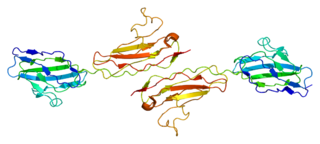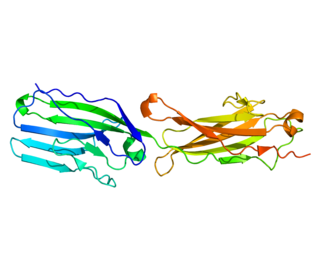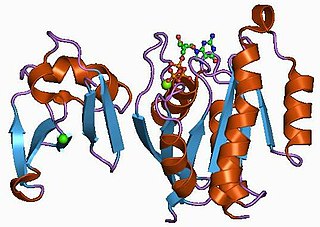
Selectin P ligand, also known as SELPLG or CD162, is a human gene.

Disintegrin and metalloproteinase domain-containing protein 15 is an enzyme that in humans is encoded by the ADAM15 gene.

Tyrosine-protein phosphatase non-receptor type 12 is an enzyme that in humans is encoded by the PTPN12 gene.

Integrin beta-5 is a protein that in humans is encoded by the ITGB5 gene.

Junctional adhesion molecule A is a protein that in humans is encoded by the F11R gene. It has also been designated as CD321.

Poliovirus receptor-related 1 (PVRL1), also known as nectin-1 and CD111 (formerly herpesvirus entry mediator C, HVEC) is a human protein of the immunoglobulin superfamily (IgSF), also considered a member of the nectins. It is a membrane protein with three extracellular immunoglobulin domains, a single transmembrane helix and a cytoplasmic tail. The protein can mediate Ca2+-independent cellular adhesion further characterizing it as IgSF cell adhesion molecule (IgSF CAM).

Partitioning defective 3 homolog is a protein that in humans is encoded by the PARD3 gene.

Junctional adhesion molecule C is a protein that in humans is encoded by the JAM3 gene.

CD166 antigen is a 100-105 kD typeI transmembrane glycoprotein that is a member of the immunoglobulin superfamily of proteins. In humans it is encoded by the ALCAM gene. It is also called CD166, MEMD, SC-1/DM-GRASP/BEN in the chicken, and KG-CAM in the rat.

Chloride intracellular channel 4, also known as CLIC4,p644H1,HuH1, is a eukaryotic gene.

Receptor-type tyrosine-protein phosphatase mu is an enzyme that in humans is encoded by the PTPRM gene.

Basal cell adhesion molecule, also known as Lutheran antigen, is a plasma membrane glycoprotein that in humans is encoded by the BCAM gene. BCAM has also recently been designated CD239.

CMP-N-acetylneuraminate-poly-alpha-2,8-sialyltransferase is an enzyme that in humans is encoded by the ST8SIA4 gene.

Hyaluronan synthase 3 is an enzyme that in humans is encoded by the HAS3 gene.

Cell adhesion molecule 3 is a protein that in humans is encoded by the CADM3 gene.

Angiomotin-like protein 1 is a protein that in humans is encoded by the AMOTL1 gene.

Endothelial cell-selective adhesion molecule is a protein that in humans is encoded by the ESAM gene.
JAML or Junctional Adhesion Molecule-Like, or AMICA1 is a JAM transmembrane protein family member. It is composed of two extracellular immunoglobulin-like domains, a membrane-spanning region, and a cytoplasmic tail involved in activation signaling. A known ligand of JAML is Coxsackie virus and Adenovirus Receptor which has been shown to localize to the tight junctions of epithelial cells.

Ras-related protein Rap-1b, also known as GTP-binding protein smg p21B, is a protein that in humans is encoded by the RAP1B gene.

A junctional adhesion molecule (JAM) is a protein that is a member of the immunoglobulin superfamily, and is expressed in a variety of different tissues, such as leukocytes, platelets, and epithelial and endothelial cells. They have been shown to regulate signal complex assembly on both their cytoplasmic and extracellular domains through interaction with scaffolding that contains a PDZ domain and adjacent cell's receptors, respectively. JAMs adhere to adjacent cells through interactions with integrins LFA-1 and Mac-1, which are contained in leukocyte β2 and α4β1, which is contained in β1. JAMs have many influences on leukocyte-endothelial cell interactions, which are primarily moderated by the integrins discussed above. They interact in their cytoplasmic domain with scaffold proteins that contain a PDZ domain, which are common protein interaction modules that target short amino acid sequences at the C-terminus of proteins, to form tight junctions in both epithelial and endothelial cells as polarity is gained in the cell.


















